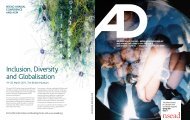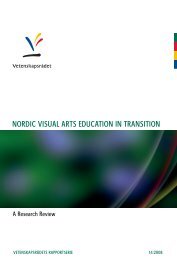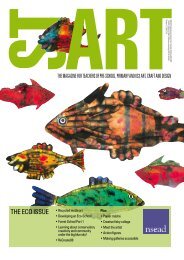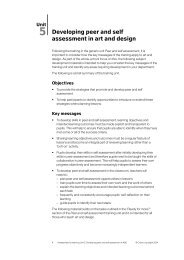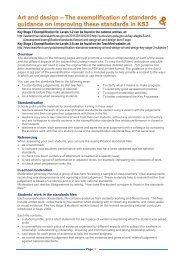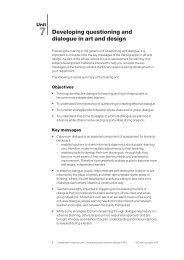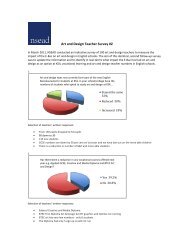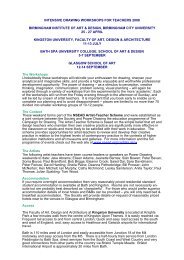Download PDF - The National Society for Education in Art and Design
Download PDF - The National Society for Education in Art and Design
Download PDF - The National Society for Education in Art and Design
You also want an ePaper? Increase the reach of your titles
YUMPU automatically turns print PDFs into web optimized ePapers that Google loves.
To f<strong>in</strong>d out more about the Reggio Emilia<br />
approach to early years education go to<br />
www.ericeece.org/reggio.html<br />
If you would like to discuss organis<strong>in</strong>g a similar<br />
project <strong>for</strong> Early Years teachers <strong>in</strong> your area,<br />
email: nigelmeager@hotmail.com<br />
17<br />
START<br />
Teachers <strong>in</strong> Reggio Emilia <strong>in</strong> Italy have<br />
pioneered approaches to early years<br />
education that place creative control <strong>in</strong> the<br />
h<strong>and</strong>s of 3 to 5 year olds. Adults are crucial<br />
support workers help<strong>in</strong>g children achieve<br />
their <strong>in</strong>tentions <strong>and</strong> <strong>in</strong>ject<strong>in</strong>g necessary<br />
skills <strong>and</strong> underst<strong>and</strong><strong>in</strong>g.<br />
<strong>The</strong> children talk a lot with the adults who<br />
are part of their team but it is the children<br />
who decide the detailed content of each<br />
stage of a project. <strong>The</strong> adults suggest<br />
rather than dictate ideas, but help with<br />
practical support as the children move on<br />
to attempt to realise their <strong>in</strong>tentions.<br />
As with any truly creative activity there is<br />
a great deal of ebb <strong>and</strong> flow, changes of<br />
direction, but gradually outcomes crystallise.<br />
Draw<strong>in</strong>gs, pa<strong>in</strong>t<strong>in</strong>gs, photographs, movement,<br />
music mak<strong>in</strong>g, stories, sculptures, puppets,<br />
fabrics, <strong>in</strong>stallations, pr<strong>in</strong>ts, digital image<br />
mak<strong>in</strong>g <strong>and</strong> much else are all possible.<br />
Along with many LEAs across the UK,<br />
Cardiff educators have taken a strong<br />
IDEAS FOR THE<br />
CLASSROOM<br />
Meet<strong>in</strong>g the pigeon man <strong>and</strong><br />
meet<strong>in</strong>g real birds<br />
John, a rac<strong>in</strong>g pigeon enthusiast, bought<br />
half a dozen sleek birds to show the<br />
children. <strong>The</strong>y could stroke <strong>and</strong> feed them.<br />
<strong>The</strong>y listened to the pigeons call to each<br />
other. John answered questions <strong>and</strong> told<br />
them stories about pigeon races <strong>and</strong><br />
car<strong>in</strong>g <strong>for</strong> the birds.<br />
Talk<strong>in</strong>g about John’s visit<br />
What can you remember about the rac<strong>in</strong>g<br />
pigeons John showed you?<br />
“We stroked them, they were racers, they<br />
had sharp claws, we had to stay quiet <strong>and</strong><br />
not shout, <strong>in</strong> case they fly away, the<br />
pigeons won prizes, won races…”<br />
Make sounds<br />
If you were a bird, what would you sound<br />
like? Use your voice to make the call of<br />
your bird. Practice lots of different calls.<br />
Why are the calls so different? What are<br />
the birds say<strong>in</strong>g?<br />
Talk about the imag<strong>in</strong>ary birds<br />
What does your bird look like? What does<br />
it do? Where does it go...?<br />
Draw your imag<strong>in</strong>ary birds<br />
<strong>The</strong>se are imag<strong>in</strong>ary birds so they do not<br />
need to look real or realistic! How strange<br />
will your bird be? You could th<strong>in</strong>k about all<br />
<strong>in</strong>terest <strong>in</strong> the Reggio Emilia philosophy<br />
<strong>and</strong> practice. Julie Ashfield, the <strong>Art</strong> <strong>Education</strong><br />
Development Officer, planned one day <strong>in</strong>service<br />
conferences <strong>for</strong> early years teachers<br />
<strong>and</strong> support staff <strong>in</strong> the city to allow them<br />
to experience the philosophy <strong>in</strong> practice.<br />
Groups of teachers took the role of children<br />
<strong>and</strong> helped direct the content, whilst the<br />
course leaders provid<strong>in</strong>g the same k<strong>in</strong>d of<br />
structure, underst<strong>and</strong><strong>in</strong>g <strong>and</strong> practical<br />
support as the Early Years teachers offer<br />
their children <strong>in</strong> Reggio Emilia.<br />
Of course, Wales is not Italy <strong>and</strong> the<br />
content of the activities as much reflected<br />
the tradition of early years arts education <strong>in</strong><br />
Cardiff as the philosophy of their Italian<br />
colleagues.<br />
<strong>The</strong> theme <strong>for</strong> the first course was birds,<br />
<strong>and</strong> <strong>for</strong> the second lorries. In each case the<br />
approach was trailed with Cardiff nursery<br />
children just a couple of days be<strong>for</strong>e the<br />
adult course. <strong>The</strong> various outcomes from<br />
the children were shared with the adults as<br />
the different parts of your bird. Would you<br />
add <strong>in</strong> beaks, bills, heads, eyes, mouths,<br />
plumes, tails, bodies, w<strong>in</strong>gs, feathers, legs,<br />
necks, claws, toes, ears…?<br />
Draw an imag<strong>in</strong>ary bird onto acetate –<br />
change the scale!<br />
Project it with the overhead projector onto<br />
a very large sheet of paper. Trace over your<br />
draw<strong>in</strong>g with large marker pens. Why not<br />
use pa<strong>in</strong>t? Make a bird that’s as big as you!<br />
F<strong>in</strong>d books about real birds. Make photocopies<br />
of pictures of real birds. Make<br />
photocopies of your imag<strong>in</strong>ary birds. You<br />
could photocopy your imag<strong>in</strong>ary bird on to<br />
the acetate <strong>and</strong> project your draw<strong>in</strong>g!<br />
What could your imag<strong>in</strong>ary birds be do<strong>in</strong>g?<br />
What do you th<strong>in</strong>k real birds do?<br />
“Fly<strong>in</strong>g south, or to the beach, or to the<br />
s<strong>and</strong>, the pond, or the sea. Eat<strong>in</strong>g worms,<br />
wheat, or bread. Look<strong>in</strong>g after baby birds,<br />
f<strong>in</strong>d<strong>in</strong>g friends, sitt<strong>in</strong>g on a wall, hang<strong>in</strong>g<br />
on trees, hav<strong>in</strong>g a rest, sleep<strong>in</strong>g, mak<strong>in</strong>g<br />
nests, stay<strong>in</strong>g <strong>in</strong> a hole or a house or a box,<br />
play<strong>in</strong>g rac<strong>in</strong>g games, slid<strong>in</strong>g games or<br />
fly<strong>in</strong>g games”<br />
But could imag<strong>in</strong>ary birds do th<strong>in</strong>gs that<br />
real birds cannot do? “Yes!”<br />
Work together to make a large collage<br />
Cut or tear out the pictures of real <strong>and</strong><br />
imag<strong>in</strong>ary birds. Glue the birds onto large<br />
sheets of paper <strong>and</strong> add your own<br />
draw<strong>in</strong>gs to show what the birds <strong>and</strong><br />
do<strong>in</strong>g <strong>and</strong> where they are now, or where<br />
they discovered <strong>for</strong> themselves how a<br />
framework <strong>for</strong> creativity could be<br />
constructed, <strong>and</strong> how as team members<br />
they could work to <strong>for</strong>ge their own content.<br />
Each group developed <strong>and</strong> then went on to<br />
express very different ideas, even though<br />
the structure <strong>in</strong>troduced by the course<br />
providers, Nigel Meager <strong>and</strong> Chris Glynn,<br />
was the same <strong>for</strong> everyone. A very similar<br />
structure was developed <strong>for</strong> lorries. To<br />
illustrate the importance underly<strong>in</strong>g<br />
structure rather than that of the simple<br />
subject of the overly<strong>in</strong>g theme, readers are<br />
<strong>in</strong>vited to substitute the idea of lorries as<br />
you read the text. For example <strong>in</strong> the very<br />
first paragraph, children could meet a lorry<br />
driver who has driven to the nursery. In the<br />
second paragraph try, “If you were a lorry<br />
what would you sound like?”<br />
On the <strong>in</strong>set days, participants constructed<br />
their own content. Examples follow of<br />
approaches that could be <strong>for</strong>ged by any<br />
team of adults <strong>and</strong> children.<br />
they are go<strong>in</strong>g. Some birds will be fly<strong>in</strong>g,<br />
some st<strong>and</strong><strong>in</strong>g, some perch<strong>in</strong>g; some will<br />
be do<strong>in</strong>g the th<strong>in</strong>gs we talked about earlier.<br />
You could put your collage on the wall <strong>and</strong><br />
use the overhead projector to add real or<br />
imag<strong>in</strong>ary birds <strong>in</strong> a different scale.<br />
Create movements <strong>for</strong> your birds<br />
How do your birds move? Are they graceful,<br />
slow, excited, jerky, clumsy, peck<strong>in</strong>g, aloof,<br />
proud, suspicious…?<br />
Make up stories about the birds<br />
Where do they live, what they are do<strong>in</strong>g?<br />
Make 3D environments <strong>for</strong> the birds that<br />
could illustrate the story.<br />
Use some of the photocopies of real or<br />
your imag<strong>in</strong>ary birds. Glue them on to<br />
pieces of card to make them stronger.<br />
Draw more ideas <strong>in</strong>to the card if there is<br />
room. How could you make the card st<strong>and</strong><br />
up, or could you fix it to a perch? Birds like<br />
to perch, sw<strong>in</strong>g, fly, st<strong>and</strong>, feed etc. Make<br />
constructions us<strong>in</strong>g cane, card, str<strong>in</strong>g,<br />
wire, paper. Fix your cardboard birds to the<br />
construction. Use your draw<strong>in</strong>gs, collages<br />
<strong>and</strong> pr<strong>in</strong>ts as a backdrop. Use the overhead<br />
projector to project large birds <strong>in</strong>to a sett<strong>in</strong>g.<br />
You could make the environment first <strong>and</strong><br />
then decide on the story.<br />
Plan a per<strong>for</strong>mance<br />
Add sounds <strong>and</strong> movement <strong>and</strong> tell a story<br />
to accompany the 3D environments. Why<br />
not record the sounds, video the movements<br />
<strong>and</strong> remember the story to tell aga<strong>in</strong> on<br />
another day.<br />
THE NEW MAGAZINE FOR PRIMARY AND PRE-SCHOOL TEACHERS OF ART, CRAFT & DESIGN




